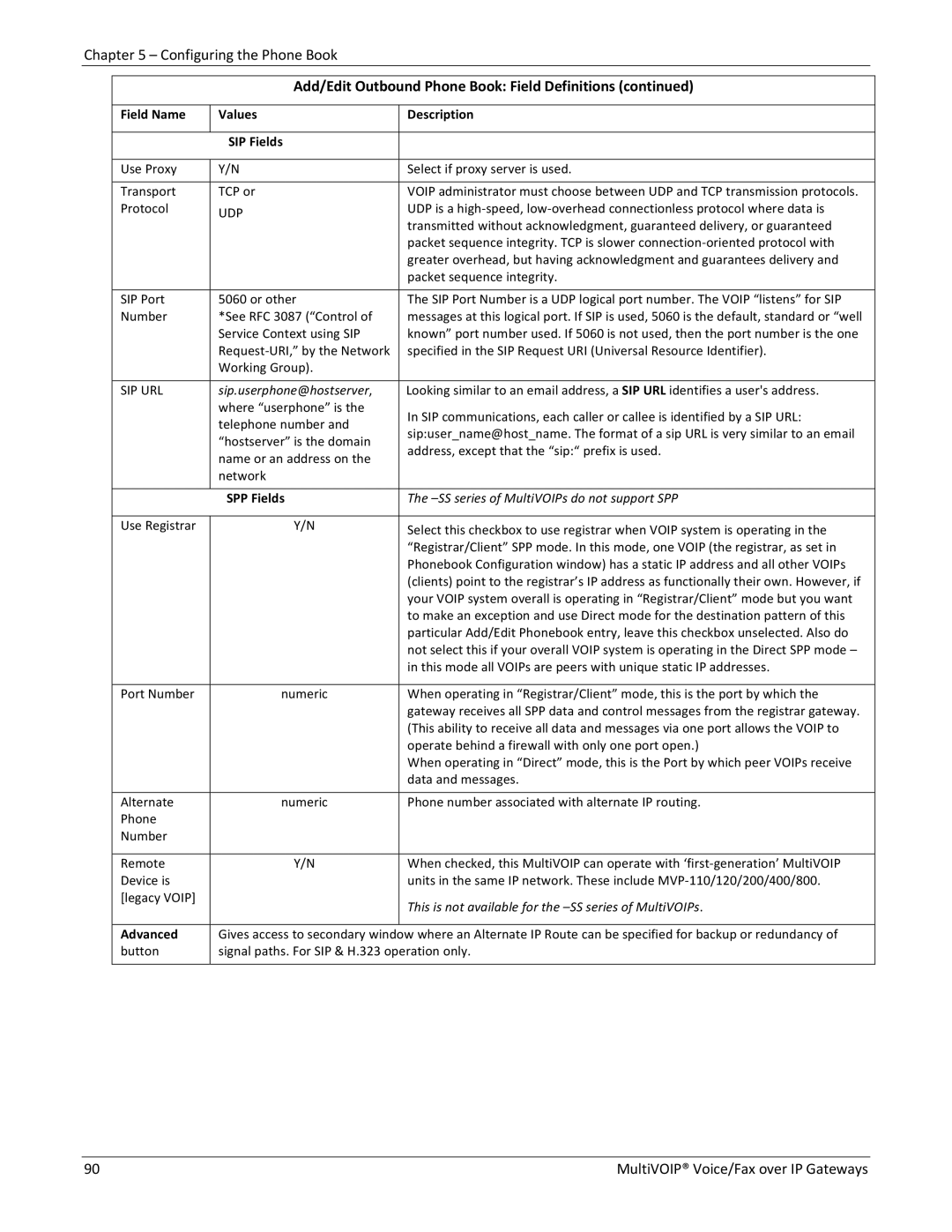
Chapter 5 – Configuring the Phone Book
| Add/Edit Outbound Phone Book: Field Definitions (continued) | |
|
|
|
Field Name | Values | Description |
|
|
|
| SIP Fields |
|
|
|
|
Use Proxy | Y/N | Select if proxy server is used. |
|
|
|
Transport | TCP or | VOIP administrator must choose between UDP and TCP transmission protocols. |
Protocol | UDP | UDP is a high‐speed, low‐overhead connectionless protocol where data is |
| transmitted without acknowledgment, guaranteed delivery, or guaranteed | |
|
| |
|
| packet sequence integrity. TCP is slower connection‐oriented protocol with |
|
| greater overhead, but having acknowledgment and guarantees delivery and |
|
| packet sequence integrity. |
|
|
|
SIP Port | 5060 or other | The SIP Port Number is a UDP logical port number. The VOIP “listens” for SIP |
Number | *See RFC 3087 (“Control of | messages at this logical port. If SIP is used, 5060 is the default, standard or “well |
| Service Context using SIP | known” port number used. If 5060 is not used, then the port number is the one |
| Request‐URI,” by the Network | specified in the SIP Request URI (Universal Resource Identifier). |
| Working Group). |
|
|
|
|
SIP URL | sip.userphone@hostserver, | Looking similar to an email address, a SIP URL identifies a user's address. |
| where “userphone” is the | In SIP communications, each caller or callee is identified by a SIP URL: |
| telephone number and | |
| sip:user_name@host_name. The format of a sip URL is very similar to an email | |
| “hostserver” is the domain | |
| address, except that the “sip:“ prefix is used. | |
| name or an address on the | |
|
| |
| network |
|
|
|
|
| SPP Fields | The |
|
|
|
Use Registrar | Y/N | Select this checkbox to use registrar when VOIP system is operating in the |
|
| |
|
| “Registrar/Client” SPP mode. In this mode, one VOIP (the registrar, as set in |
|
| Phonebook Configuration window) has a static IP address and all other VOIPs |
|
| (clients) point to the registrar’s IP address as functionally their own. However, if |
|
| your VOIP system overall is operating in “Registrar/Client” mode but you want |
|
| to make an exception and use Direct mode for the destination pattern of this |
|
| particular Add/Edit Phonebook entry, leave this checkbox unselected. Also do |
|
| not select this if your overall VOIP system is operating in the Direct SPP mode – |
|
| in this mode all VOIPs are peers with unique static IP addresses. |
|
|
|
Port Number | numeric | When operating in “Registrar/Client” mode, this is the port by which the |
|
| gateway receives all SPP data and control messages from the registrar gateway. |
|
| (This ability to receive all data and messages via one port allows the VOIP to |
|
| operate behind a firewall with only one port open.) |
|
| When operating in “Direct” mode, this is the Port by which peer VOIPs receive |
|
| data and messages. |
|
|
|
Alternate | numeric | Phone number associated with alternate IP routing. |
Phone |
|
|
Number |
|
|
|
|
|
Remote | Y/N | When checked, this MultiVOIP can operate with ‘first‐generation’ MultiVOIP |
Device is |
| units in the same IP network. These include MVP‐110/120/200/400/800. |
[legacy VOIP] |
| This is not available for the |
|
| |
|
|
|
Advanced | Gives access to secondary window where an Alternate IP Route can be specified for backup or redundancy of | |
button | signal paths. For SIP & H.323 operation only. | |
|
|
|
90 | MultiVOIP® Voice/Fax over IP Gateways |
